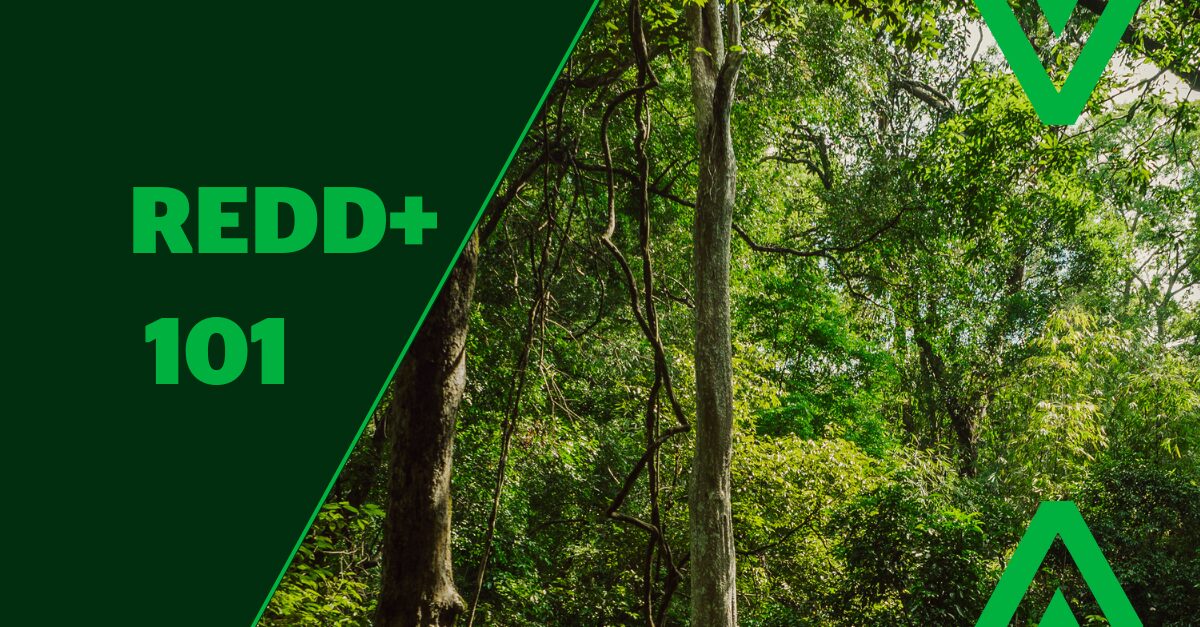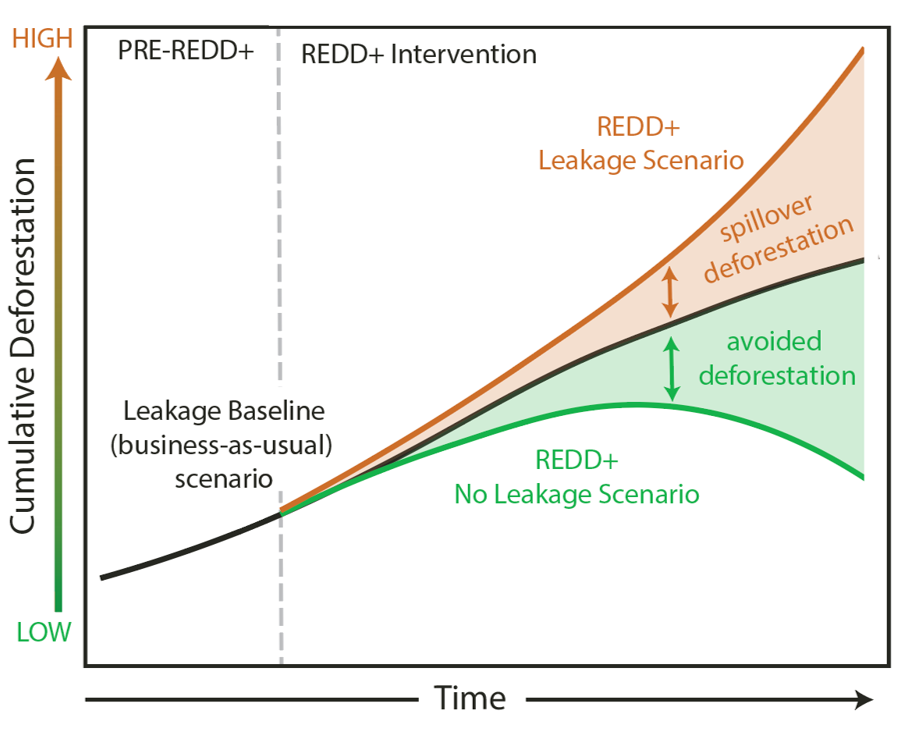
The likelihood of long-term REDD+ intervention success, lasting forest conservation and subsequent avoided greenhouse gas (GHG) emissions – rely not only on the reasonableness of the baseline, but also on various other technical factors including: additionality, leakage and risk.
Additionality is defined as the positive effects that result from an intervention (in this case REDD+) compared to what would have occurred in the absence of the intervention (or REDD+ project). In the case of REDD+, additionality is commonly only viewed in relation to the avoided GHG emissions that occur as a result of reducing the deforestation and degradation of a project’s landscape over time compared to the business-as-usual – accounted for within a project’s baseline and leakage emissions.
Whilst this is vital to the underpinning of the REDD+ mechanism as a carbon offset, other forms of additionality are essential to adequately transform the local drivers of deforestation into durable forest conservation – including community, biodiversity, climate change mitigation and financial additionality.

This represents all positive benefits the local community members receive as a result of agreeing to conserve rather than convert the forest. Perhaps the most important community benefit is economic incentives, which can take the form of new culturally-appropriate alternative sustainable income streams, project employment opportunities and/or the direct provision of a proportion of the project’s income in the form of cash. Other benefits are often centered around providing basic needs and developing new infrastructure, including access to quality education, new medical facilities and care, obtaining clean water resources, new sanitation facilities and improved food security. Without community buy-in and direct allocation of benefits, a REDD+ intervention simply would not work. Hence, this type of additionality should be considered as a core benefit rather than a co-benefit of REDD+ projects.
Together the strength and reach of these community benefits can be measured to define the level of community additionality above what would have been achieved without REDD+ income generation. However, a deep understanding of the local socioeconomic context, community dynamics and FPIC (free, prior and informed consent) processes are required to adequately quantify this type of additionality.
Biodiversity Additionality encompasses the improved welfare of wildlife located within a REDD+ project area compared to the baseline case. In the most basic form, local wildlife benefit from the improved protection of their forest habitats through reduced habitat fragmentation (via avoided deforestation) and safeguarded forest integrity (via reduced degradation). Regions with highly biodiverse ecosystems, a high degree of endemism and/or high number of threatened species (i.e. IUCN Red Listed species) tend to be viewed as having relatively high biodiversity additionality. Yet, projects with the highest biodiversity additionality also include more targeted activities such as robust science-based biodiversity monitoring programs, direct protection against poaching and trafficking (via patrolling and persecution of offenders as well as rescue of captured wildlife), reduced human-wildlife conflicts, and improved awareness and perception of wildlife amongst local communities (through outreach and eco-tourism).
This represents the level and impact of activities targeting mitigation of climate change risks. Tropical regions (where REDD+ projects tend to be located) are typically at great risk of negative climate change impacts – including increased frequency and magnitude of extreme weather events (e.g. heatwaves, drought, flooding, wildfires) and altered seasonality which result in water and food shortages for communities and wildlife alike. Whilst REDD+ projects are not currently required to develop activities to mitigate such climate change impacts, those that do demonstrate high Climate Change Mitigation Additionality, which ultimately result in more durable long-term benefits for forests, communities and wildlife. Climate mitigation activities vary depending on the local circumstances, but can include extreme weather resilient infrastructure, water resources and food systems. For example, the Wildlife Works Kasigau Corridor REDD+ Project has introduced drought tolerant crops to community greenhouse programs, water infrastructure for communities and wildlife (watering holes) and a school meals program to alleviate food security during droughts.
This form of additionality describes the level of financing (via the sale of REDD+ verified carbon units) required above the baseline case to ensure the protection of a project area forest. The type and level of financing that would be available in the baseline case is highly dependent on the local context and can be highly variable through time (particularly when dependent on short-term conservation grants). For example, in the case of legally Protected Areas (e.g. national parks and wildlife sanctuaries), they must not have received sufficient public and/or philanthropic financing historically to adequately protect the landscape against unplanned (illegal) deforestation and degradation to be considered financially additional. This is a common scenario amongst tropical protected areas which often require more rigorous patrol systems to protect against infiltration of agricultural frontiers in areas that typically have low rule of law. For example, the Wildlife Conservation Society Keo Seima Wildlife Sanctuary REDD+ Project is technically within a protected area in Cambodia – however, funding for policing of laws is very limited. In fact, the adjacent Snuol Wildlife Sanctuary has been nearly completely deforested due to limited funding – resulting in a degazetting of the protected status in 2018.
Furthermore, conservation corridors between Protected Areas also have particularly high financial additionality as most often there are limited conservation actors working to conserve the forest. This is the case of the Wildlife Works Kasigau Corridor REDD+ Project – located between Tsavo East and Tsavo West National Parks in Kenya.
Leakage is the spillover impact of conservation mitigations, usually coined in the negative as the forest loss and greenhouse gas emissions occurring in surrounding regions. Such leakage can be attributed to conservation interventions if the underlying drivers aren’t adequately and systematically addressed. In REDD+ programs, leakage is accounted for in REDD+ verification of carbon offsets through a regular monitoring process where any land use change within a defined Leakage Area beyond the baseline is discounted from the gross offsets achieved by the project.
Leakage Areas are established on a project-by-project basis, either in the form of a buffer zone around the project area or a defined area of land adjacent to the project where spillover deforestation is predicted to occur. REDD+ projects with strong theory of change frameworks as well as high community and biodiversity additionality tend to demonstrate lower levels of leakage over time. Specifically, projects that have developed expansive theory of change interventions that link to drivers outside of the project boundaries (e.g. government policies, advocacy) and tend to be very effective.
Example REDD+ leakage scenarios (see below) compared to the business-as-usual (baseline) leakage deforestation rate expected in the absence of the project.

If deforestation within the Leakage Area is higher than the Leakage Baseline, spillover deforestation is likely occurring as a result of halting/slowing deforestation within the project area. In this case, the greenhouse gas emissions resulting from such spillover deforestation are subtracted from the project’s avoided deforestation in the calculation of net emissions reductions and ultimately verified carbon units. Alternatively, if leakage drivers are adequately managed, the actual deforestation within the Leakage Area will decrease compared to the Leakage Baseline, resulting in avoided deforestation.
Given the high level of investment into forest conservation activities, the permanence of REDD+ interventions is often assessed to ensure any risks that could undermine the durability of forest protection are adequately mitigated. Furthermore, REDD+ projects are allocated a risk score on a regular basis, which is used to determine the quantity of gross emissions reductions that must be subtracted and placed within a global buffer pool (essentially as an insurance contribution in case of emissions reductions reversals). Risks associated with REDD+ interventions are often either natural or anthropogenic.
Natural risks
Include any natural phenomena that could result in the medium- to long-term destruction or degradation of forest ecosystems, including forest fires, drought, flooding and biotic disease. Many of these risks are expected to occur more frequently, impact larger forest areas and/or occur concurrently as a result of climate change. Whilst many of these natural risks cannot be fully mitigated, some REDD+ activities can limit their influence on the carbon carrying capacity of the forest ecosystem such as wildfire monitoring and management (via fire brigades, reduced ignition sources and altered behavior) and reducing the introduction of non-native species into the landscape.
Anthropogenic risks
Includes any social, economic or policy activity that could result in the reversal of forest conservation. For example, the active participation of local community members is required to ensure project forests remain standing – this risk can be alleviated by ensuring continuous FPIC, appropriate benefit sharing, community co-management of project activities and strong community additionality through the project lifetime. Economic incentives for local communities or other deforestation drivers must be adequately addressed through a project’s theory of change – if activities do not balance these incentives, reversal is likely. Finally, political backing is particularly important as forest and protected area policies can result in total reversal of project activities – for example, if a project is housed on state owned protected land, it is vital that there is a level of permanence to this land tenure (i.e. it cannot be reversed for more profitable alternatives). Projects that frequently reflect on their theories of change and adapt frequently using a methodology like the Social and Biodiversity Impact Assessment (SBIA) tend to better capture and manage for performance risks.
It is important that risks and ultimate project permanence be considered within reason – REDD+ projects cannot realistically ensure permanent protection of forests beyond the period during which project activities are taking place and not all risks can be fully mitigated. In theory, if REDD+ interventions are successful then REDD+ financing should be redundant after a 30-year period. However, no REDD+ projects have reached this milestone yet. Given the ever increasing risk to forests as climate change reaches a tipping point and populations continue to rise, it is likely that REDD+ projects will need to intervene over longer than the typical 30-year project period.